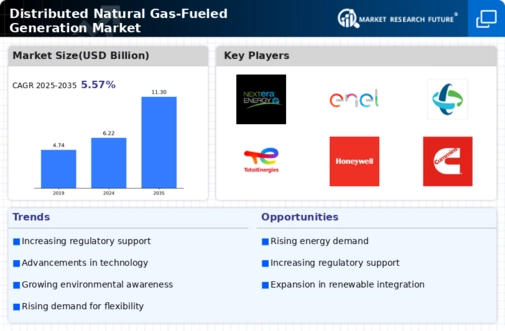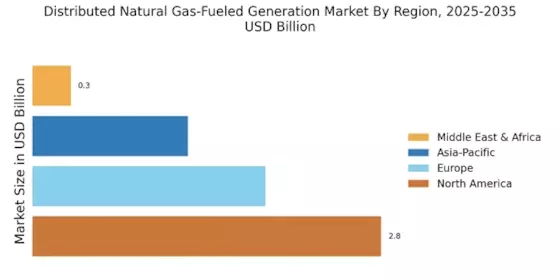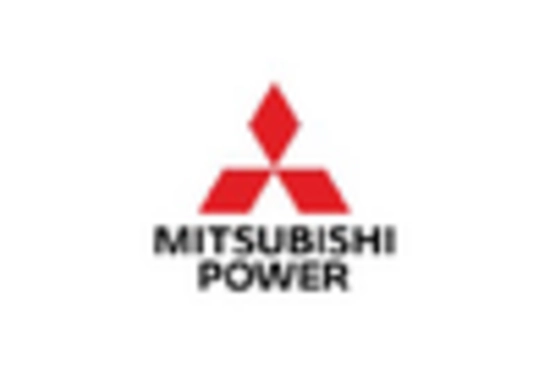Regulatory Incentives and Support
The regulatory landscape plays a crucial role in shaping the Distributed Natural Gas-Fueled Generation Market. Governments are increasingly implementing policies that promote the use of natural gas as a cleaner alternative to coal and oil. Incentives such as tax credits, grants, and subsidies for natural gas projects are becoming more common, encouraging investment in distributed generation technologies. For instance, certain regions have established renewable portfolio standards that include natural gas as a qualifying resource. This regulatory support not only fosters market growth but also aligns with broader environmental goals. As a result, the Distributed Natural Gas-Fueled Generation Market is likely to benefit from these favorable policies, which could lead to increased adoption of natural gas technologies in various sectors.
Decentralization of Energy Production
The trend towards decentralization in energy production is reshaping the Distributed Natural Gas-Fueled Generation Market. As energy consumers seek greater control over their energy sources, distributed generation systems are gaining traction. This shift allows for localized energy production, reducing transmission losses and enhancing grid resilience. Moreover, the proliferation of microgrids and community energy projects is facilitating the integration of natural gas technologies at the local level. Data suggests that decentralized energy systems can improve energy access and reliability, particularly in remote areas. As such, the Distributed Natural Gas-Fueled Generation Market is likely to see increased investment and innovation in decentralized solutions, aligning with the broader movement towards energy independence.
Rising Demand for Clean Energy Solutions
The growing demand for clean energy solutions is a significant driver for the Distributed Natural Gas-Fueled Generation Market. As concerns about climate change intensify, stakeholders are increasingly seeking alternatives to traditional fossil fuels. Natural gas is often viewed as a transitional fuel that can help reduce greenhouse gas emissions while supporting the shift towards renewable energy sources. Recent statistics indicate that natural gas-fired power plants emit approximately 50% less carbon dioxide compared to coal-fired plants. This environmental advantage positions the Distributed Natural Gas-Fueled Generation Market favorably in the context of global energy transitions. Consequently, the increasing emphasis on sustainability is likely to propel the adoption of natural gas technologies in various applications.
Economic Viability and Cost Competitiveness
Economic factors are pivotal in driving the Distributed Natural Gas-Fueled Generation Market. The cost of natural gas has remained relatively stable compared to other energy sources, making it an attractive option for power generation. Additionally, advancements in technology have led to a decrease in the capital costs associated with natural gas generation systems. Recent analyses indicate that the levelized cost of electricity (LCOE) for natural gas plants is competitive with that of renewables in many regions. This economic viability is likely to encourage further investment in distributed generation technologies, as businesses and utilities seek to optimize their energy portfolios. Consequently, the Distributed Natural Gas-Fueled Generation Market is poised for growth as stakeholders recognize the financial benefits of natural gas solutions.
Technological Innovations in Distributed Generation
The Distributed Natural Gas-Fueled Generation Market is experiencing a surge in technological innovations that enhance efficiency and reduce emissions. Advanced combined heat and power (CHP) systems are becoming increasingly prevalent, allowing for the simultaneous generation of electricity and useful heat. This dual output not only maximizes energy utilization but also minimizes waste. Furthermore, the integration of smart grid technologies facilitates real-time monitoring and management of energy resources, optimizing performance. According to recent data, the efficiency of natural gas generators has improved significantly, with some systems achieving efficiencies exceeding 90%. This trend towards higher efficiency is likely to drive growth in the Distributed Natural Gas-Fueled Generation Market, as stakeholders seek to leverage these advancements to meet energy demands sustainably.


















Leave a Comment